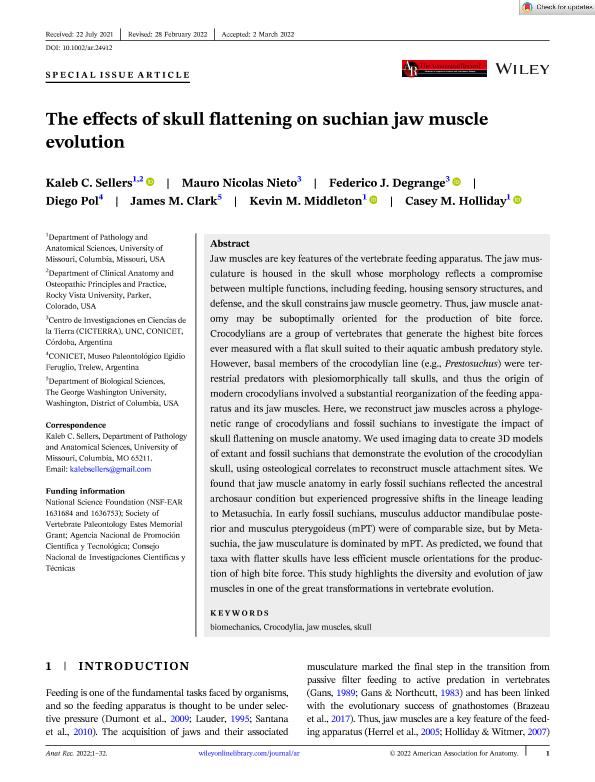Artículo
The effects of skull flattening on suchian jaw muscle evolution
Sellers, Kaleb C.; Nieto, Mauro Nicolas ; Degrange, Federico Javier
; Degrange, Federico Javier ; Pol, Diego; Clark, James M.; Middleton, Kevin M.; Holliday, Casey M.
; Pol, Diego; Clark, James M.; Middleton, Kevin M.; Holliday, Casey M.
 ; Degrange, Federico Javier
; Degrange, Federico Javier ; Pol, Diego; Clark, James M.; Middleton, Kevin M.; Holliday, Casey M.
; Pol, Diego; Clark, James M.; Middleton, Kevin M.; Holliday, Casey M.
Fecha de publicación:
06/2022
Editorial:
Wiley-liss, div John Wiley & Sons Inc.
Revista:
Anatomical Record-Advances in Integrative Anatomy and Evolutionary Biology
ISSN:
1932-8486
Idioma:
Inglés
Tipo de recurso:
Artículo publicado
Clasificación temática:
Resumen
Jaw muscles are key features of the vertebrate feeding apparatus. The jaw musculature is housed in the skull whose morphology reflects a compromise between multiple functions, including feeding, housing sensory structures, and defense, and the skull constrains jaw muscle geometry. Thus, jaw muscle anatomy may be suboptimally oriented for the production of bite force. Crocodylians are a group of vertebrates that generate the highest bite forces ever measured with a flat skull suited to their aquatic ambush predatory style. However, basal members of the crocodylian line (e.g., Prestosuchus) were terrestrial predators with plesiomorphically tall skulls, and thus the origin of modern crocodylians involved a substantial reorganization of the feeding apparatus and its jaw muscles. Here, we reconstruct jaw muscles across a phylogenetic range of crocodylians and fossil suchians to investigate the impact of skull flattening on muscle anatomy. We used imaging data to create 3D models of extant and fossil suchians that demonstrate the evolution of the crocodylian skull, using osteological correlates to reconstruct muscle attachment sites. We found that jaw muscle anatomy in early fossil suchians reflected the ancestral archosaur condition but experienced progressive shifts in the lineage leading to Metasuchia. In early fossil suchians, musculus adductor mandibulae posterior and musculus pterygoideus (mPT) were of comparable size, but by Metasuchia, the jaw musculature is dominated by mPT. As predicted, we found that taxa with flatter skulls have less efficient muscle orientations for the production of high bite force. This study highlights the diversity and evolution of jaw muscles in one of the great transformations in vertebrate evolution.
Palabras clave:
BIOMECHANICS
,
CROCODYLIA
,
JAW MUSCLES
,
SKULL
Archivos asociados
Licencia
Identificadores
Colecciones
Articulos(CICTERRA)
Articulos de CENTRO DE INVEST.EN CS.DE LA TIERRA
Articulos de CENTRO DE INVEST.EN CS.DE LA TIERRA
Citación
Sellers, Kaleb C.; Nieto, Mauro Nicolas; Degrange, Federico Javier; Pol, Diego; Clark, James M.; et al.; The effects of skull flattening on suchian jaw muscle evolution; Wiley-liss, div John Wiley & Sons Inc.; Anatomical Record-Advances in Integrative Anatomy and Evolutionary Biology; 305; 10; 6-2022; 2791-2822
Compartir
Altmétricas



